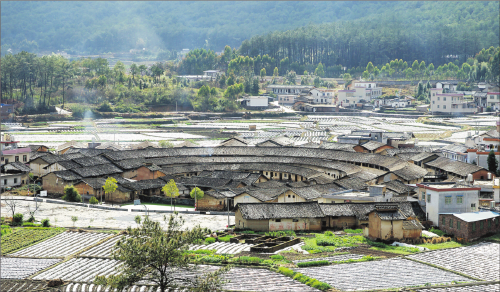
HUANG LINGBO/CHINA DAILY
Weiwu (self-encircling houses) scattered in Meizhou, Guangdong province, are one of the most visible examples of the Hakka way of living.

CHINA DAILY
Surrounded by a theme park on all things Hakka, the Hakka Park offers villas suitable for summer retreats and deluxe rooms with park views.
If Hakka are permanent guests from North China, Meizhou in eastern Guangdong province is the perfect locale to showcase their hospitality, writes Raymond Zhou.
The Hakka people are so intensely proud of their heritage that you'd be forgiven if you mistook them for a separate ethnicity. But they are just as Han as anyone else of the majority race in China, perhaps more so than people who live in northern China, where the ethnicity hailed from. Customs and speech patterns evolved separately from the mainstream, and these inhabitants of southern China have stubbornly maintained them as a lifestyle and as an identity.
Currently 70 million strong in number, the Hakka first relocated to the south more than 2,000 years ago as part of Emperor Qin's 1 million-plus troops. Wars and social disturbances in later years sent more migrants down south into the mountainous provinces of what are now Guangdong, Fujian, Jiangxi and Guangxi.
The most visible evidence of the Hakka way of living is its architecture. Called weiwu (self-encircling house) in Meizhou and tulou (mud building) in Fujian, it is a mammoth compound that housed an entire clan, often with hundreds of residents. While tulou is usually round in shape, weiwu can be square or rectangular or curved on one side. The size of a weiwu is identified by the number of encirclements. For example, I was told there are weiwu with as many as five compounds, one within another.
I had the good fortune to visit Pan'anwei, about an hour from downtown Meizhou, which is the center of Hakka culture. By no means the largest of its kind, it is however the best preserved because inhabitants did not build their separate new houses on the premises or very close to it, as others have done, but moved a respectable distance away, leaving the old architecture, built in 1895, as it was.
There are now only a dozen people living in it, all senior citizens whose sense of responsibility to protect the property handed down from their ancestors is stronger than that of the young generation. That means most of the 122 rooms are lying vacant. Some seem to have been left deserted for decades.
There are three circles of buildings, with only the middle one in a crescent shape. The outermost has four corners that are reinforced like a fortress, complete with embrasures. You can imagine how hard it would have been for those who lived inside to be attacked by bandits. In that sense, the weiwu was not just an abode but a refuge from danger.
The Hakka people were constantly in search of a better life. Many emigrated farther away to Southeast Asia and other destinations. There are some 10 million who now live overseas. In the old town of Songkou, there is an old bridge, constructed with donations from former residents who had made it overseas, one can still detect faint traces of the town's glory days.
The port here served as the point of departure for hundreds of thousands of Hakka wayfarers who said goodbye to their loved ones and embarked on perilous journeys. Many of them never returned-other than as guests. But they poured their love and money into improving their hometowns and the country at large. Many supported Dr Sun Yat-sen's fight for democracy. Songkou has the first public park in China, and it's appropriately named Zhongshan (Sun Yat-sen) Park. It is now almost a generic name for parks throughout the country.
Songkou is quite dilapidated. The river has long ceased its function as a channel for transportation and thus a gateway to the outside world. The street closest to the river is the only one that has kept its original architecture, now in ubiquitous decay. But many microfilms set their stories, or at least the opening shot for location, in this town. (The purpose of my trip to Meizhou and its vicinity was to serve on the jury for a film competition that promotes the Hakka culture.)
While the weiwu demonstrates Hakka's inward-looking and self-protecting nature, the Meijiang River, which runs through many Hakka-inhabited towns, is a silent witness to the adventure seekers who broke free of the conventions and shackles in pursuit of their dreams. The Hakka played crucial roles in many uprisings and revolutions.
The most celebrated nowadays is Ye Jianying (1897-1986), a Communist general whose trips back home are depicted in enlarged photographs festooning his ancestral household. The compound is a fraction of the size of a typical weiwu but also home to an extended family.
A much bigger home I visited was that of Huang Zunxian (1848-1905), a poet, educator and diplomat whose support for reform caused his downfall from official grace during the Qing Dynasty (1644-1911). His efforts to protect the interests of overseas Chinese and improve their education is the stuff of legend among those who settled abroad. Now his residence serves as a gallery for plaques of all kinds.
If you find Cantonese hard to comprehend, you may be surprised that the Hakka dialect is easier to understand. That's because it comes from the dialects of Henan province, which was more or less solidified in the Southern Song Dynasty (1127-1279). Use Hakka to read ancient poems and you'll realize many of the rhymes suddenly make sense.
As a matter of fact, the Hakka dialect could be living proof of how much of the Central Plains culture has been retained and how much assimilation with the southern culture has taken place. Before mass migration becomes a daily occurrence, the Hakka's perseverance in carrying on ways of old has turned it into a museum of sorts.
